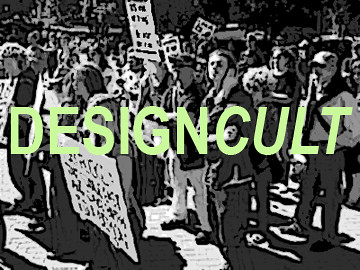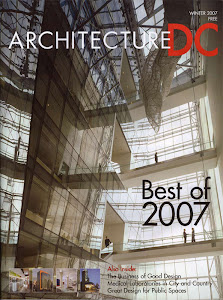
 Downtown Washington has never had quite an inspiring aspect when it comes to innovative architecture. The building boom from the 1960's to the 1980's left the city with blocks of monotonous concrete corporate boxes which created a bleakness which was echoed by the lack of urban energy on the streets. Many historic mixed use buildings were torn down to make way for these cheap and efficient solutions whose sole intentions were for workday uses. What were once vibrant downtown streets that had storefront shopping, classy hotels, apartments and offices became a barren wasteland that was only utilized during business hours, and a dead zone during the evenings and weekends. The last ten years these once ignored neighborhoods have been regaining their lost urban vitality. The historic buildings have been restored to house shops, restaurants and modern office spaces. The incorporation of museums, large scale infill buildings designed as mixed use, and the re-conversion of shabby apartment buildings into hip downtown condos has brought people back into these neglected zones. Now these areas are bustling not only during the workday but with restaurant goers in the evenings and tourists and shoppers on weekends. Residents now inhabit these streets 24-7 to add to the base population. The popular elements of design for the 21st century of green design and modern and light filled work spaces have also created a craze downtown to turn the bunker-like concrete blocks into more modern buildings. Powerhouse corporate firms are seeing that these design elements can be used as a marketing tool and sign of prestige for their companies. The Washington Post has done a number of articles regarding this subject. Many developers and building owners want this transformation for the buildings they own that may have ideal locations but dated and dismal designs. One way to achieve this is to just completely tear down the existing structure, as is currently happening on several blocks of the K Street corridor. Another way is to strip the interiors to the concrete structure of floor slabs, staircases and columns, and to rip the entire or part of the exterior facade off as well. These skeletons are then re-fit with modern and more efficient systems and a more desirable facade. The easier solution for the facade replacement is to just clad the building in a glass and steel curtain wall system. This design will give the exterior a more current look and the interiors with day light filled office spaces that will be more pleasant to work in. This solution does accomplish these two goals, but at the same time, does the building become more architecturally significant and a more positive addition to the urban street scape? Does replacing a concrete facade with punched window openings with a standard glass and steel wall system create a better architecture? Yes, the buildings might contain more pleasant spaces to inhabit, but will block after block of flat glass facades be more interesting and significant than flat concrete and glass facades? I think that if no unique design solutions are incorporated into these building facelifts, the new look will have the same effect as the original facades, unoriginal, uninspired, and not architecturally significant. There are ways to avoid this problem. One way is to incorporate modern glass elements into the existing concrete formwork of the original facade. This allows for a variation in materiality and adds more of a vibrancy to the building. One successful example is the building at 1110
Downtown Washington has never had quite an inspiring aspect when it comes to innovative architecture. The building boom from the 1960's to the 1980's left the city with blocks of monotonous concrete corporate boxes which created a bleakness which was echoed by the lack of urban energy on the streets. Many historic mixed use buildings were torn down to make way for these cheap and efficient solutions whose sole intentions were for workday uses. What were once vibrant downtown streets that had storefront shopping, classy hotels, apartments and offices became a barren wasteland that was only utilized during business hours, and a dead zone during the evenings and weekends. The last ten years these once ignored neighborhoods have been regaining their lost urban vitality. The historic buildings have been restored to house shops, restaurants and modern office spaces. The incorporation of museums, large scale infill buildings designed as mixed use, and the re-conversion of shabby apartment buildings into hip downtown condos has brought people back into these neglected zones. Now these areas are bustling not only during the workday but with restaurant goers in the evenings and tourists and shoppers on weekends. Residents now inhabit these streets 24-7 to add to the base population. The popular elements of design for the 21st century of green design and modern and light filled work spaces have also created a craze downtown to turn the bunker-like concrete blocks into more modern buildings. Powerhouse corporate firms are seeing that these design elements can be used as a marketing tool and sign of prestige for their companies. The Washington Post has done a number of articles regarding this subject. Many developers and building owners want this transformation for the buildings they own that may have ideal locations but dated and dismal designs. One way to achieve this is to just completely tear down the existing structure, as is currently happening on several blocks of the K Street corridor. Another way is to strip the interiors to the concrete structure of floor slabs, staircases and columns, and to rip the entire or part of the exterior facade off as well. These skeletons are then re-fit with modern and more efficient systems and a more desirable facade. The easier solution for the facade replacement is to just clad the building in a glass and steel curtain wall system. This design will give the exterior a more current look and the interiors with day light filled office spaces that will be more pleasant to work in. This solution does accomplish these two goals, but at the same time, does the building become more architecturally significant and a more positive addition to the urban street scape? Does replacing a concrete facade with punched window openings with a standard glass and steel wall system create a better architecture? Yes, the buildings might contain more pleasant spaces to inhabit, but will block after block of flat glass facades be more interesting and significant than flat concrete and glass facades? I think that if no unique design solutions are incorporated into these building facelifts, the new look will have the same effect as the original facades, unoriginal, uninspired, and not architecturally significant. There are ways to avoid this problem. One way is to incorporate modern glass elements into the existing concrete formwork of the original facade. This allows for a variation in materiality and adds more of a vibrancy to the building. One successful example is the building at 1110 
Vermont Avenue. It's simple design solution adds a fresh face and creates an interplay between the old and the new. Other buildings try to play with a layering effect by adding different glazing patterns and opacity to the surface. Creating a certain depth to the building elevation will definitely help its presence on the street. Much of the design flaw in the straightforward glass cladding comes from the lack of a combination of horizontal and vertical elements. These buildings due to the height restrictions seem squat. By adding a prominent vertical element, whether it be in the form of a tower or just mixing the orientations of the metal frameworks can allow these buildings to rid themselves of that short boxy stigma. Angled or undulating elements added to the facades can also create a more unique diversity. Some of the new buildings that were constructed from the ground up employ these design moves to make them stand out from their less inspired neighbors. This revitalization of DC's downtown is most welcome. The city needs to take advantage of this opportunity to turn it's street corridors into a fantastic and vibrant urban architecture that gives this city a modern global image. Modern design updates are not always the best solution to a problem. They are a great solution when they are incorporated in an innovative, creative and intelligent way.



Sunday, April 13, 2008
Downtown : Facade Facelifts
Subscribe to:
Post Comments (Atom)









No comments:
Post a Comment